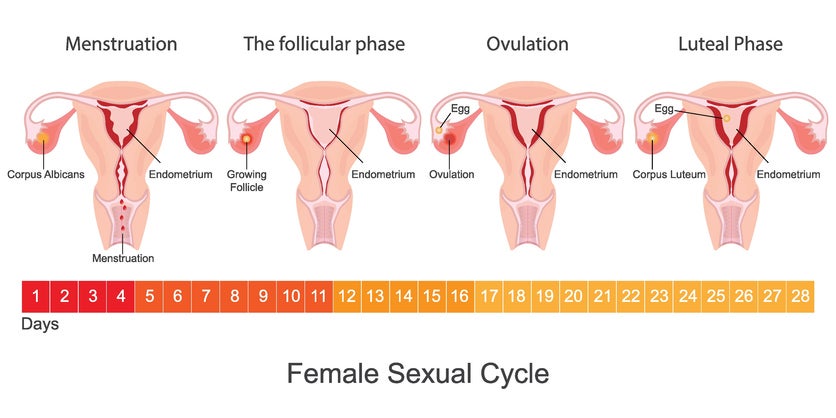Crimson Revelations: Unraveling the Secrets of Menstrual Cycles and Hormonal Rhythms
July 1, 2025
By: WakeMed Health & Hospitals
Categories: Women's, Primary Care
Tags: menstruation, luteal phase, ovulation, follicular phase, monthly cycle
Medically reviewed by Chantel Roedner, MD, FACOG
The "monthly flow," "visit from Auntie Red" or "crimson tide" is a typical experience for women, lasting between three to seven days and accompanied by symptoms of cramps, bloating, clotting, acne and more. Some women feel a sense of relief when it appears, recognizing that it indicates they are not expecting a baby. Others nonchalantly regard it as a regular occurrence each month and remain vigilantly prepared.
A woman's fertility cycle holds greater significance beyond those few days. Every month, women experience a cycle that consists of the menstrual, follicular, ovulatory and luteal phases. It typically ranges from 25 to 35 days, with the possibility of some slight variations. Combined, these factors create a monthly change in fertility that affects a woman’s energy, emotions, body shape and even her food cravings.
We sat down with WakeMed OB-GYN Chantel Roedner, MD, FACOG, to learn more about the monthly cycle and what women can expect.
About menstruation
Menstruation serves the function of releasing a mature egg while also getting the body ready for fertilization and implantation, which are essential for a successful pregnancy. On average, the age range for most females to being menstruation is between 11 and 13 years. Older or younger girls might have abnormalities, or may be influenced by factors, such as weight, race, ethnicity, family background, and athletic ability can affect the timing of when girls begin menstruating. It is crucial that parents speak with a pediatrician whenever they have questions regarding the onset of their child's menstruation.
Menstruation lasts up to a week, typically varying between three to seven days, with an approximate total blood loss of around 80 milliliters (which is roughly five tablespoons) throughout the cycle. A standard tampon can absorb approximately 5 milliliters of blood, whereas a super plus tampon can hold around 15 milliliters of blood.
Women are classified as experiencing unusually heavy bleeding if they lose over 80 milliliters of blood during their menstrual period. If bleeding is affecting one's physical, social or emotional well-being, it raises concerns and would require further examination. Medications or surgery can help to reduce flow.
Mood impact: Once the period begins, hormonal sensations of irritability or feelings of sadness begin to fade away. When the period concludes, women might experience an increase in social engagement and happiness.

The follicular phase
During the first part of the menstrual cycle, referred to as the follicular phase, significant events occur in both the ovaries and the uterus. Menstruation begins on the first day of this phase, which lasts until ovulation happens, typically enduring for about 13 to 14 days within an average 28-day cycle.
This is a description of the occurrences that happen:
- Hormone levels fluctuate: At the beginning of this phase, the levels of hormones, especially estrogen and progesterone, reach their lowest point. Follicle-stimulating hormone (FSH) and luteinizing hormone (LH) are released by the pituitary gland, prompting the ovaries to become active.
- Follicle development: The growth of multiple follicles in the ovaries is stimulated by FSH. These follicles contain undeveloped eggs.
- Estrogen production: While the follicles are maturing, a type of estrogen known as estradiol begins to be generated.
- Choosing the dominant follicle: Usually, one follicle stands out as the dominant one and proceeds to develop, while the other follicles shrink in size.
- Rise in estrogen: The dominant follicle releases more estradiol, causing the endometrium, or uterine lining, to thicken in preparation for a potential pregnancy.
- Ovulation trigger: A rise in estradiol causes the release of LH, which in turn stimulates the dominant follicle to rupture and release the egg, a process referred to as ovulation.
- Uterine lining becomes thicker: Higher levels of estrogen facilitate the growth of both the myometrium and endometrium in the uterus, creating an ideal environment for potential implantation.
- Increase in LH and FSH: Higher levels of estradiol in the blood result in an elevated secretion of LH and FSH from the pituitary gland, which helps in the release of the egg. In essence, the ovaries are prepared for ovulation during the follicular phase, and at the same time, the uterus is readied for a potential fertilized egg.
Mood impact: In this stage, there is an increase in estrogen levels, commonly linked to heightened energy, an uplifted mood and an overall sense of wellness. During this period, some women might notice an increase in their confidence and engagement with others.
Body impact: The follicular phase marks the point at which women experience their lowest weight after their menstrual cycle. Hormonal changes that occur in the luteal phase, which is the time leading up to menstruation, can cause the body to retain water and result in a short-term increase in weight.
The ovulation phase
The ovulation phase is when the body releases the egg. A hormonal cascade happens, and estrogen and luteinizing hormones increase, triggering the egg. Women undergo some cellular changes to prepare for fertilization or pregnancy, when the egg is released from the follicle. This fertile window lasts on average for about six days and increases a woman's sexual desire.
Some women have pain, some pretty intense. Some may feel when they ovulate, knowing on which side they're ovulating. Cramping, breast tenderness and vaginal spotting are common. Additionally, during ovulation, vaginal discharge alters to a clear, elastic and slick texture, frequently compared to that of raw egg whites.
Mood impact: In this stage, the levels of estrogen reach their highest point, often resulting in heightened feelings of joy, vitality and self-assurance. The decrease in estrogen levels following ovulation can result in feelings of irritability, mood fluctuations and sadness.
The luteal phase
The luteal phase begins after ovulation and brings on menses if a woman doesn't conceive, typically about 10 to 14 days long. The luteal phase produces progesterone until the embryo implants or if the progesterone falls, estrogen subsequently drops. That triggers the menstrual cycle.
Mood impact: During this time when progesterone is increasing, some women are more sensitive to the change. They may be more tired, have more mood changes, have issues with sleep, experience increased feelings of stress and a reduced sex drive.
In the luteal phase, women might notice physical changes that can range from mild to significant. These signs may appear regardless of whether conception has occurred or not. When not expecting a baby, this condition is usually called premenstrual syndrome (PMS).
Body impact: Fluctuations in hormone levels may result in bloating and a short-term increase in weight. The luteal phase, which takes place following ovulation, frequently leads to bloating and water retention as a result of progesterone. Changes in appetite and cravings may occur during this phase, which can result in a rise in caloric consumption and fluctuations in weight.
In the luteal phase, the hormone progesterone can impede digestion, leading to bloating. Other potential physical signs include these:
- Pimples appearing on the skin
- Shifts in hunger cues and short-term increase in weight
- Bowel issues, whether it’s constipation or diarrhea
- Tiredness
- Gassiness
- Head pain
- Awareness of light and sound
- Achy, sensitive breasts
Women amaze
The monthly cycle can be valuable to understand reproductive health and bodily changes.
About Chantel Roedner, MD, FACOG
 Dr. Chantel Roedner joined WakeMed Physician Practices as an OB/GYN after completing her residency at The University of North Carolina at Chapel Hill and earning her medical degree at the Medical University of South Carolina in Charleston. She received her undergraduate degree from the College of Charleston.
Dr. Chantel Roedner joined WakeMed Physician Practices as an OB/GYN after completing her residency at The University of North Carolina at Chapel Hill and earning her medical degree at the Medical University of South Carolina in Charleston. She received her undergraduate degree from the College of Charleston.
Her clinical interests include high risk obstetrics, infertility, minimally invasive gynecological surgery including robotic surgery, well woman care and contraception.
Dr. Roedner has received several awards for excellence in teaching and surgery including the Golden Tar Heel teaching award, Gynecology Excellence in Surgery Award, OBGYN Resident of the Year, Midwifery Chief Resident award and Association of Professors in Gynecology and Obstetrics Excellence in Teaching award.
When not working, Dr. Roedner enjoys spending with her child. She also loves hiking local trails and traveling with her husband.